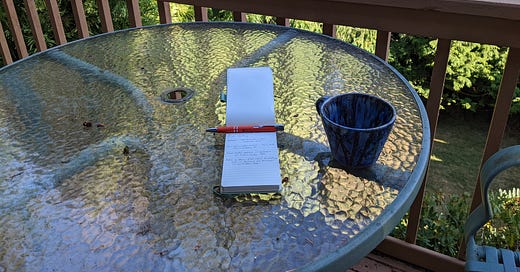I’m going to leave the intro from TT #1 pinned here for new readers. For today’s new post, scroll down below the photo:
These should be fairly self-explanatory. They’re not formulas or, God knows, rules. They’re exercises to try, and ways of framing, and maybe challenges that will lead you to solutions to the individual problems your writing projects are already plotting to hurl at you. All of these are things I’ve developed (or borrowed and augmented) over the last quarter-century, and that at least some people have found useful.
If you find these helpful, and want to show appreciation or encouragement, please do tell friends, or say so somewhere. And/or click the little purple button below, if you’re able and so inclined. Many thanks.
As noted in yesterday’s Maxim Monday post, I consider “showing” a category, not a goal. It’s a set of tools for engulfing readers in moments rather than summarizing, and therefore should be used primarily for moments worth the immersion.
First of all, a bit of reframing:
Never mind show vs. tell; let’s talk objective vs. subjective.
A little quiz. Ready?
What’s the difference between objective and subjective language?
Right. Good. Objective = fact. Subjective = Involving emotion or opinion; something that can be argued. (Yeah, okay, insert joke I wish were funny here about facts being the things that can be argued…smh…).
So. Given the above, which do you think is the more efficacious for expressing emotion or opinion?
Can’t slip one past you lot, can I?
It’s true, though. When you want to show— make readers feel, and experience— that’s when you want to lean hardest on objective, factual language.
A quick example, ripped right from today’s climate change headlines:
Which sounds hotter:
Subjective version: It was (____) in the car. (Fill in blank with hottest adjective or set of adjectives you can think of. I think today I’ll go with scalding. Sound warm?
Objective version: The sweat on my back cemented me to the car seat, and the skin on my arm had bubbled into blisters where the sun poured through the windshield.
See what I mean?
With subjective language, the best you can hope for is that your reader believes you. But nail the objective description, and your reader will bubble and blister right along with your characters.
There are definitely tricks that can help you wield the sword of objectivity effectively.
Here’s one:
Verbs are your friends.
The English language is an artist’s dream palette replete with shades for action. Using the right synonym for walk, for example— skip, creep, stumble, etc.— will go a long way toward setting the tempo and tone of the moment you’re painting, and bringing that moment to life. And it’s entirely objective. You’re not commenting on your character’s movements; you’re describing accurately what they are.
More tips for showing well next Tuesday.
Hope these help.



